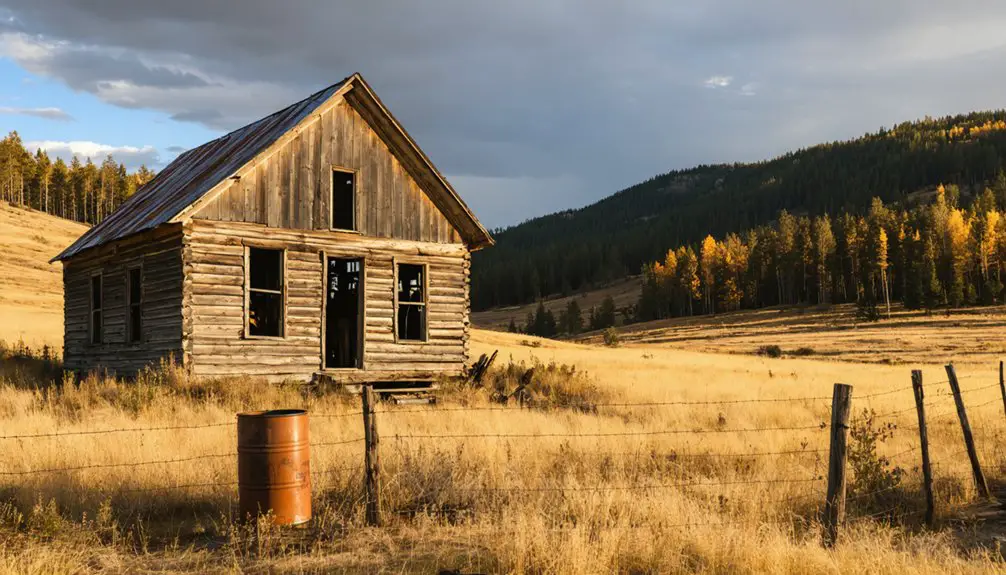You’ll find Disautel’s ghost town ruins along Washington State Route 155, where this former logging community once thrived during the early 1900s timber boom. The town served as a hub for Biles-Coleman Lumber Company operations until the Great Depression devastated the local economy, with lumber production plummeting from 7.3 billion to 2.2 billion feet annually. Today, crumbling foundations and scattered remnants offer glimpses into the Pacific Northwest’s rich logging heritage and boom-and-bust past.
Key Takeaways
- Disautel is a former logging town in Washington state that declined after the Great Depression severely impacted the region’s timber industry.
- The town’s remaining structures and foundations serve as remnants of a once-thriving logging community centered around the Biles-Coleman Logging Company.
- Visitors can explore the ghost town through self-guided tours, though access may be limited by seasonal conditions and environmental concerns.
- The site represents the boom-and-bust cycle common to Pacific Northwest resource towns and attracts history enthusiasts and photographers.
- Founded in 1924, the town prospered during the timber industry’s peak but gradually declined as lumber production decreased and economic conditions changed.
The Rise of a Logging Empire
As eastern forests dwindled in the late 1800s, Midwestern lumber barons set their sights on Northeast Washington’s vast timber resources, sparking a dramatic transformation of the region’s logging industry.
You’ll find the story dominated by Frederick Weyerhaeuser, who alongside John A. Humbird, acquired extensive tracts of pristine Western white pine forest across the Washington-Idaho border.
The introduction of steam-powered logging techniques revolutionized timber harvesting, while railroad expansion opened up previously unreachable forest areas. The Shay locomotive’s introduction in 1881 provided superior traction capabilities for transporting logs across rough terrain.
Through aggressive timber consolidation, Weyerhaeuser’s empire grew to control 26% of Washington’s private timberland by 1913.
The formation of the Clearwater Timber Company in 1900 and Charles A. Weyerhaeuser’s 30,000-acre purchase leading to Potlatch Lumber Company marked key steps in establishing corporate dominance over the region’s timber wealth.
By 1907, the region’s lumber production had reached unprecedented levels with over 100 mills operating throughout Northeast Washington.
Life in Early Disautel
If you’d visited early Disautel, you would’ve found a tight-knit community where the day began before sunrise as loggers headed to the surrounding forests while their families maintained the camp’s daily operations.
After work hours, residents gathered for simple entertainments like storytelling, card games, and occasional community events centered around the shared experiences of logging life. Similar to the practices of Washington’s native peoples, these gatherings involved extensive discussion and listening as community members shared their thoughts and concerns. Disease outbreaks like smallpox epidemics had previously devastated many similar communities in the 1770s.
The general store served as both a supply hub and social center, where workers could purchase necessities and exchange news while their families caught up on local happenings.
Daily Logging Camp Activities
While most timber towns developed gradually, life in early Disautel’s logging camps followed a regimented daily schedule designed to maximize productivity.
You’d start your day before sunrise in the bunkhouse, where fresh sheets and thick mattresses guaranteed you’d be well-rested for the demanding work ahead. The camp hierarchy, led by experienced foremen, organized crews into specialized roles – from sawyers felling timber to loaders managing heavy equipment. Archaeological evidence from similar camps like St. Paul and Tacoma shows a rich material culture of daily life. Having JavaScript enabled was essential for camp operations to coordinate daily logging activities through their modern communications system.
Your logging techniques would vary with the seasons, but the work remained intense year-round.
Between shifts, you’d head to the central kitchen for hearty meals designed to fuel long hours of physical labor. After dusk, you’d clean up in the camp’s basic but functional washrooms before returning to your bunk to rest for another day in the woods.
Social Life and Entertainment
Despite the demanding nature of logging work, Disautel’s residents carved out rich social lives centered around communal gatherings and outdoor recreation.
You’d find townspeople coming together for seasonal celebrations, shared meals, and lively dances where music filled makeshift venues. The surrounding wilderness offered plenty of opportunities for hiking, fishing, and hunting when you weren’t working at the mill.
The boarding houses and communal mess halls became natural hubs for socializing, while families tended small gardens and gathered for storytelling sessions around evening campfires. Much like the historic mining town of Liberty’s gold rush, these social gatherings helped build lasting community connections.
Children’s play and school events strengthened community bonds, and traveling entertainers occasionally brought fresh excitement to town. Similar to Chesaw’s early days, the town maintained a bustling social scene with its saloons and hotel gatherings.
Whether you were sharing news at the local saloon or joining a group excursion to nearby landmarks, there was always a way to connect with your neighbors.
Small Town General Store
The heartbeat of early Disautel’s commercial life pulsed from its general store, an essential hub where loggers and their families could find everything from work boots to coffee beans.
You’d discover wooden shelves stocked with dry goods, canned foods, and specialized logging equipment, all arranged behind a sturdy counter that faced the entrance. The store’s general store evolution reflected the town’s timber industry, with its lumber-built structure and rustic fixtures illuminated by kerosene lamps. Much like the former lumber barn it would become decades later, the building stood as a testament to the area’s rich logging heritage. Following the tradition of stores like Swain’s, the shop maintained an impressive collection of military surplus gear.
More than just a shop, it served as a community gathering spot where you could collect mail, share news, or warm yourself by the wood stove.
When cash was tight, the store’s informal credit system helped keep food on local tables until the next payday from the sawmill.
Biles-Coleman’s Industrial Legacy
Founded in 1924, Biles-Coleman Lumber Company emerged as a cornerstone of regional development when it established a sawmill near Omak Mountain. The company’s industrial heritage grew to include dry kilns, a plywood plant, and a power facility, employing hundreds of local workers throughout much of the 20th century.
You’ll find the company’s impact extended beyond lumber production. They partnered with the Colville Indian Reservation for timber resources and transformed Camp Disautel into an educational site.
Despite attempts at economic resurgence through various ownership changes – from Crown Zellerbach to worker ownership and Quality Veneer and Lumber – the operation faced challenges.
While the mill’s final closure in 2009 marked the end of an era, its legacy lives on through the community structures and educational programs it helped establish.
Daily Operations at the Sawmill
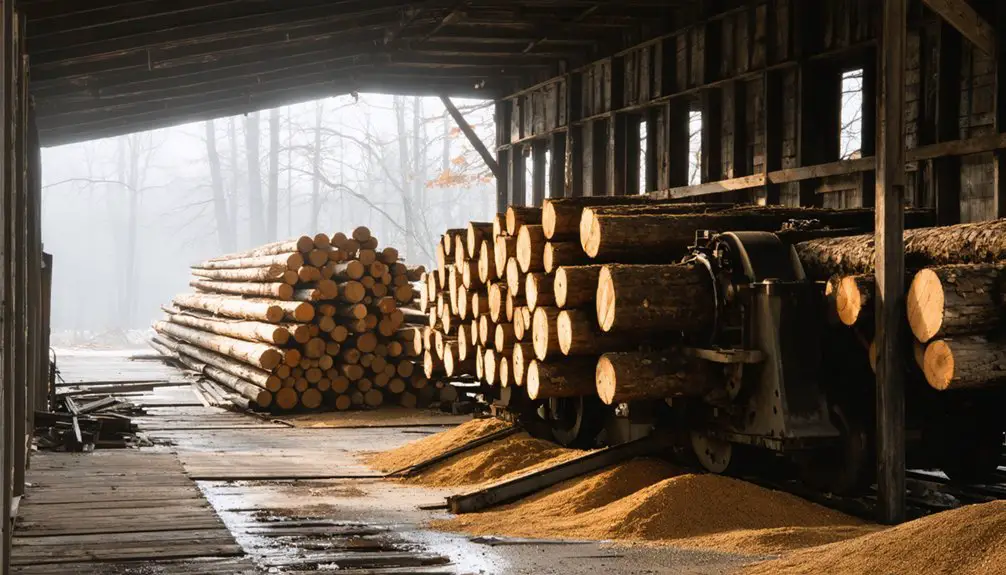
If you’d visited Disautel’s sawmill in the 1920s, you’d have seen workers arriving before dawn to inspect steam-powered equipment and sharpen massive saw blades for the day’s cutting.
The mill’s daily rhythm centered on the coordinated effort between truck drivers delivering logs from the forest and mill hands who used cant-dogs to maneuver timber onto carriages for precise cutting into lumber.
Safety procedures were essential, with workers maintaining clear escape routes and staying vigilant around dangerous machinery, especially during the intensive 10-12 hour shifts that characterized the early American lumber industry.
Mill Worker Daily Routines
Operating a sawmill in Disautel required precise coordination among workers who arrived before sunrise to maximize production during daylight hours. The sawmill workflow demanded skilled sawyers to operate the main saws while laborers managed heavy log transport.
Worker safety remained paramount, with morning briefings and required protective gear inspections before shifts began.
- Maintenance crews performed equipment checks and blade sharpening throughout the day.
- Steam donkeys and motor trucks moved logs from storage ponds to processing areas.
- Mid-shift inspections guaranteed mechanical wear and safety hazards were identified.
- Breaks were staggered to maintain continuous production.
- End-of-day procedures included systematic power-down and thorough cleanup.
The coordinated effort between sawyers, laborers, and maintenance personnel kept the mill running efficiently from dawn until the final safety walk-through at dusk.
Log Processing and Equipment
Three core pieces of equipment formed the backbone of Disautel’s sawmill operations: the TimberKing 2520 band sawmill with its robust Kubota diesel engine, Cook’s Saw AE-4E edger, and the Woodmaster W-4000 planer.
You’ll find this log processing setup housed within a 3,600-square-foot quonset building on tribal land, where coastal western hemlock logs are transformed into finished lumber products.
The mill’s hydraulic systems handle the heavy lifting, moving logs efficiently through each processing stage.
Once logs are cut using the TimberKing’s computer-controlled software, they’re edged to remove irregular sides, then planed to uniform dimensions.
Two Nyle L200 Pro dehumidification kilns complete the process, drying the lumber to prevent warping and guarantee quality in the final product.
Safety and Emergency Procedures
Safety stood paramount at Disautel’s sawmill, where extensive protocols protected workers from the inherent dangers of lumber processing.
You’d find a thorough system of safety training and emergency drills designed to keep every worker alert and prepared. The site’s dedicated safety officer guaranteed strict compliance with protective measures while maintaining open communication about potential hazards.
- Mandatory PPE requirements included hard hats, gloves, and hearing protection
- Strategic placement of fire-fighting equipment and first aid stations throughout the facility
- Clear marking of evacuation routes and muster points for emergency situations
- Regular equipment inspections and maintenance to prevent mechanical failures
- Implementation of lockout/tagout procedures during repairs and maintenance
Workers underwent continuous training to recognize hazards and respond effectively to emergencies, creating a culture where safety awareness became second nature in daily operations.
Transportation and Regional Connections
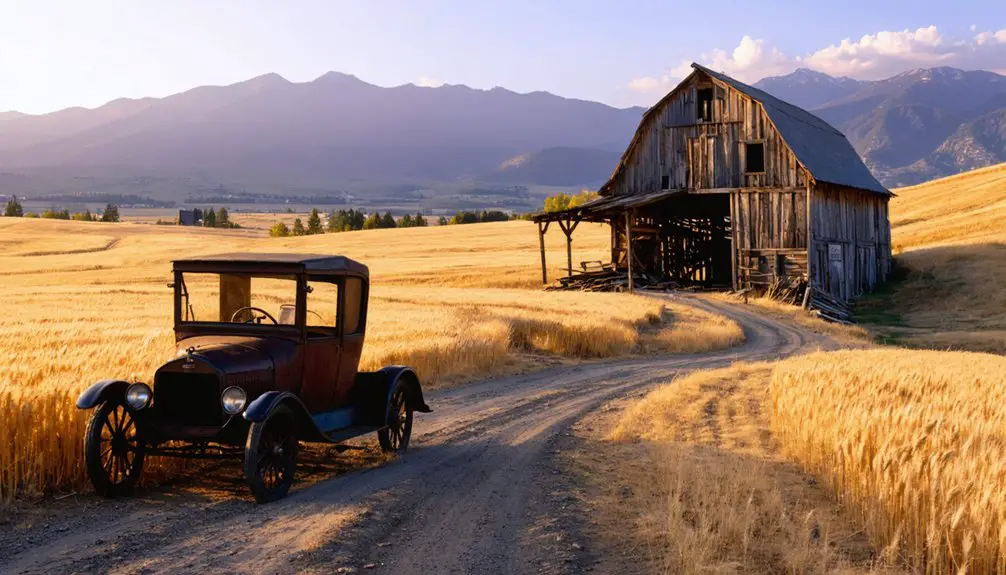
Transportation played a pivotal role in Disautel’s rise and decline, with the Northern Pacific Railroad serving as the town’s lifeline until 1941.
You’ll find the town’s story deeply intertwined with the region’s timber industry, as rail lines provided essential access for lumber distribution from the dense forests to major market hubs like Portland and Spokane.
When transportation shifts occurred, Disautel faced increasing regional isolation. The railroad’s rerouting in 1941 dealt a devastating blow to the community, which had relied heavily on rail-based lumber shipments for its economic survival.
Today, you can reach the ghost town primarily via secondary roads, a stark contrast to its heyday when rail connections integrated it into the Pacific Northwest’s thriving timber trade network.
The Great Depression’s Impact
The Great Depression struck Disautel with devastating force in late 1929, compounding the challenges already facing this timber-dependent community.
As lumber production across Washington plummeted from 7.3 billion to 2.2 billion feet annually, you’d have witnessed Disautel’s mills struggling with the same economic struggles that paralyzed the entire state.
The region’s labor unrest and widespread unemployment in the timber industry hit particularly hard, with mill unemployment reaching 50% by 1931.
- Local farmland values plunged alongside wheat prices, which fell to just 38 cents per bushel.
- Unemployed workers joined organizations like the Unemployed Citizens League.
- Federal relief programs arrived slowly to remote areas like Disautel.
- Community members relied heavily on local support networks.
- The timber industry’s collapse led to widespread property abandonment.
Remnants of a Bygone Era
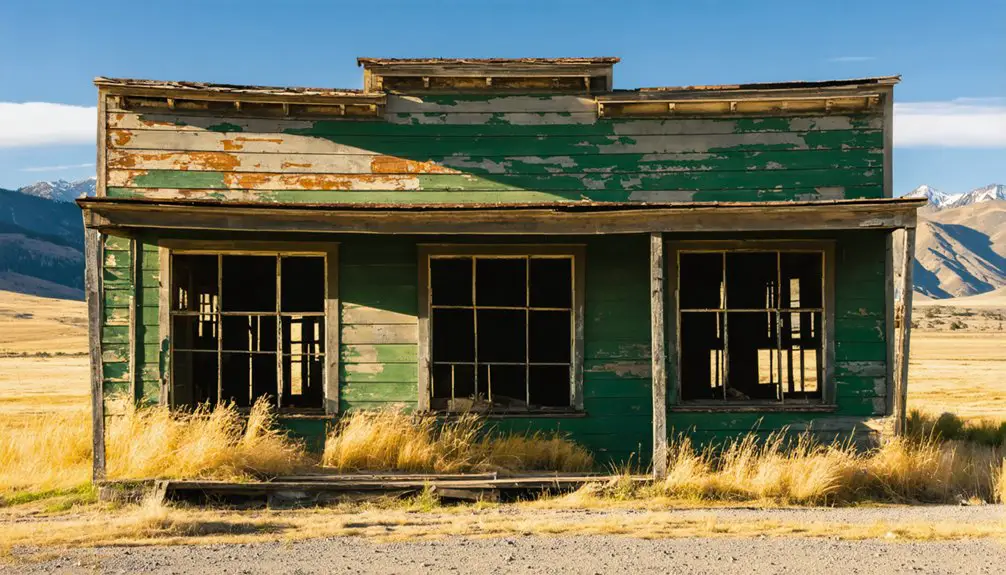
Standing as silent witnesses to a once-thriving logging community, Disautel’s remaining structures tell the story of its industrial past through crumbling foundations and weathered warehouses.
You’ll find the remnants of the Biles-Coleman Logging Company headquarters, where abandoned sawmill buildings briefly served as Highway Department storage before succumbing to decay.
Today, these logging legacies attract history enthusiasts and photographers who document the site’s ghost town archaeology.
While Washington State Route 155 still provides easy access to the town’s remains, you won’t find much beyond deteriorating buildings and scattered foundations.
The site now serves as a tribute to the boom-and-bust cycle of Pacific Northwest resource towns, preserving fragments of early 1900s logging industry practices for future generations to explore.
Geographic Features and Natural Surroundings
Nestled in Okanogan County‘s rugged terrain, Disautel occupies a strategic position near its namesake mountain pass, approximately 15 miles east of Omak along State Route 155.
You’ll find yourself surrounded by dramatic geological formations typical of northeastern Washington, where dense coniferous forests blanket the landscape. The area’s diverse wildlife habitats support a rich ecosystem of native species, from large mammals to migratory birds.
- Mixed forests of pine, fir, and cedar dominate the surrounding hillsides
- Natural waterways cut through the rugged terrain, historically essential for transportation
- The continental climate brings snowy winters and warm, dry summers
- Seasonal weather patterns shape the region’s unique forest ecology
- Mountain passes and historic trails connect to broader Okanogan Country
Notable Buildings and Structures
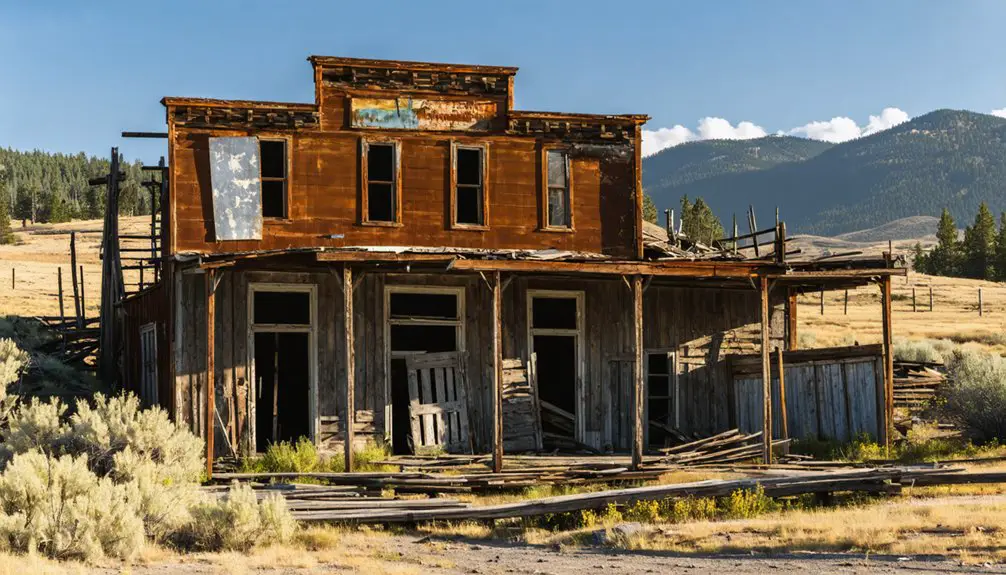
Buildings in Disautel primarily centered around the Biles-Coleman Logging Company’s operations, with its headquarters serving as the town’s industrial anchor during its prime years.
The site’s logging infrastructure included essential operational buildings and sawmill facilities that drove the local economy until the Great Depression forced shutdowns.
You’ll find that after the sawmill’s closure, the Highway Department repurposed several abandoned warehouses to store road maintenance equipment, though these structures were eventually deserted too.
While Washington State Route 155 runs through the area, any transport-related buildings that might’ve supported logging operations haven’t survived.
Unlike other regional ghost towns, Disautel lacked extensive commercial development, focusing instead on worker-related structures.
Today, most buildings lie in ruins, with former worker housing and community structures having largely disappeared.
Modern-Day Ghost Town Tourism
While Disautel’s physical structures have largely crumbled, modern visitors still seek out this ghost town’s remaining traces.
Today’s ghost town tourism faces challenges similar to other historic sites across America, where maintaining sustainable travel initiatives becomes essential for preservation.
- You’ll find fewer organized tours compared to previous years, reflecting broader tourism industry struggles.
- The site’s remote location requires careful planning as amenities are limited.
- Local community efforts focus on responsible visitation to protect remaining historical elements.
- Environmental concerns impact accessibility during certain seasons.
- Photography and self-guided exploration are the primary visitor activities.
Despite these challenges, Disautel’s appeal lies in its authentic representation of Washington’s past, offering you a genuine glimpse into the region’s history without the commercialization found at more developed ghost town sites.
Frequently Asked Questions
Are There Any Reported Ghost Sightings or Paranormal Activity in Disautel?
You won’t find documented ghost encounters or spectral activity in this former logging town. While it’s called a ghost town due to abandonment, there aren’t verified reports of paranormal phenomena.
Can Visitors Legally Explore and Photograph the Remaining Structures Today?
Like a cautious explorer mapping uncharted territory, you’ll need to verify property ownership first. There aren’t specific visitor guidelines or photography permits, but you must get permission to avoid trespassing violations.
What Native American Tribes Originally Inhabited the Disautel Area?
You’ll find the area was traditionally inhabited by bands now part of the Confederated Tribes of the Colville Reservation, including the Okanogan and Nespelem tribes, whose cultural significance remains tied to these ancestral lands.
Were Any Movies or Television Shows Ever Filmed in Disautel?
Drawing a blank here – you won’t find any movies or TV shows filmed in this location. Despite Washington’s rich cinematic history, Disautel hasn’t served as a film location.
Did Any Notable Historical Figures Ever Visit or Live in Disautel?
You won’t find records of any famous guests in Disautel’s history. The town’s historical significance centered on logging operations, with no documented visits from notable figures during its brief active period.
References
- https://en.wikipedia.org/wiki/Disautel
- https://www.therockerbox.com/okanogan_county_wa_ghost_towns.htm
- http://www.ghosttownsusa.com/okanco.htm
- https://freepages.history.rootsweb.com/~gtusa/usa/wa.htm
- https://washingtonourhome.com/washington-only-living-ghost-town/
- https://www.historylink.org/File/23257
- https://www.historylink.org/File/23208
- https://sites.uw.edu/cspn/evergreen-state/
- https://www.washington.edu/uwired/outreach/cspn/Website/Classroom Materials/Curriculum Packets/Evergreen State/Section II.html
- https://www.nwcouncil.org/history/Logging/
